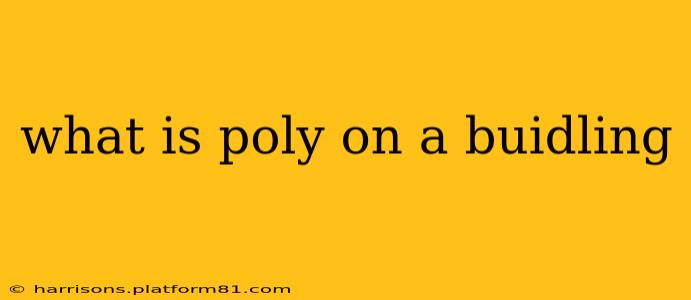The term "poly" on a building usually refers to polyurethane foam (PUF), a versatile material used extensively in construction for various purposes. It's not a single entity but rather a family of materials with diverse applications, each impacting the building's performance differently. Understanding its roles is crucial to appreciating its widespread use.
What is Polyurethane Foam Used For in Construction?
Polyurethane foam's versatility stems from its unique properties: it's lightweight yet strong, provides excellent insulation, and acts as a sealant, making it a go-to choice for numerous building applications. Here's a breakdown:
1. Insulation:
This is arguably the most common use. Polyurethane foam, both spray foam and rigid boards, excels at thermal insulation, preventing heat loss in winter and heat gain in summer. This translates to:
- Reduced energy bills: By minimizing the need for heating and cooling, it significantly lowers energy consumption.
- Improved indoor comfort: More consistent temperatures throughout the building create a more comfortable living or working environment.
- Enhanced building performance: Better insulation contributes to a building's overall efficiency and environmental friendliness.
2. Air Sealing:
Polyurethane foam's ability to expand and fill gaps and crevices makes it an ideal air sealant. This prevents air infiltration, leading to:
- Reduced drafts: Eliminates uncomfortable drafts and cold spots.
- Improved indoor air quality: Minimizes the infiltration of outdoor pollutants.
- Increased energy efficiency: Reduces the amount of energy lost through air leakage.
3. Structural Support:
In some cases, polyurethane foam can provide structural support, particularly in:
- Roofing: Spray foam can be used as a structural element in certain roof designs.
- Insulation of Cavity Walls: Filling cavities with spray foam provides both insulation and structural integrity.
4. Waterproofing:
Certain types of polyurethane foam offer waterproofing capabilities, protecting the building envelope from moisture damage. This is particularly useful in areas prone to high humidity or rain.
Types of Polyurethane Foam Used in Construction
The type of polyurethane foam used influences its properties and applications. Common types include:
- Spray polyurethane foam (SPF): Applied as a liquid and expands to fill cavities and create a seamless insulation layer. This is a popular choice for filling walls and attics.
- Rigid polyurethane foam boards: Pre-fabricated boards used for insulation in walls, roofs, and floors. They're easier to install than spray foam but may not provide as airtight a seal.
What are the Pros and Cons of Using Polyurethane Foam?
Like any building material, polyurethane foam has advantages and disadvantages:
Pros:
- Excellent insulation value: High R-value per inch.
- Air sealing capabilities: Creates an airtight barrier.
- Versatility: Can be used in various applications.
- Lightweight: Reduces the overall weight of the building.
- Durable and long-lasting: Provides long-term insulation and protection.
Cons:
- Cost: Can be more expensive than some other insulation materials.
- Installation: Spray foam requires specialized equipment and trained professionals.
- Potential for off-gassing: Some foams may release volatile organic compounds (VOCs). Choose low-VOC or zero-VOC options to mitigate this.
- Flammability: While treated to be fire-retardant, it is still combustible.
What are the different types of polyurethane foam insulation?
As mentioned above, the primary types are spray polyurethane foam (SPF) and rigid polyurethane foam boards. Within these categories, variations exist based on density, R-value, and other properties. Choosing the right type depends on the specific application and building requirements.
Is polyurethane foam environmentally friendly?
The environmental impact of polyurethane foam is a complex issue. While it contributes to energy savings through improved insulation, the manufacturing process and potential for VOC emissions raise concerns. However, advancements in technology have led to the development of more environmentally friendly options with lower VOC content and recycled content.
This comprehensive overview aims to clarify the role of "poly" (polyurethane foam) in building construction. Remember that consulting with qualified professionals is crucial to ensure proper selection and installation for optimal performance and safety.
